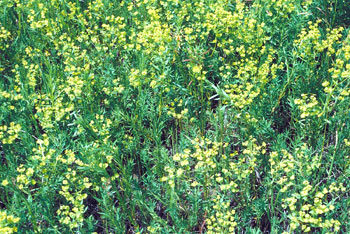 NATIVE
RANGE NATIVE
RANGE
Europe and Asia
DESCRIPTION
Leafy
spurge is characterized by plants containing a white milky sap and flower
parts in three's. Leafy spurge is an erect, branching, perennial herb 2 to
3½ feet tall, with smooth stems and showy yellow flower bracts. Stems
frequently occur in clusters from a vertical root that can extend many feet
underground. The leaves are small, oval to lance-shaped, somewhat frosted
and slightly wavy along the margin. The flowers of leafy spurge are very
small and are borne in greenish-yellow structures surrounded by yellow bracts.
Clusters of these showy, yellow bracts open in late May or early June, while
the actual flowers do not develop until mid-June.
ECOLOGICAL THREAT
Leafy
spurge displaces native vegetation in prairie habitats and fields through
shading and by usurping available water and nutrients and through plant toxins
that prevent the growth of other plants underneath it. Leafy spurge is an
aggressive invader and, once present, can completely overtake large areas
of open land.
 DISTRIBUTION
IN THE UNITED STATES DISTRIBUTION
IN THE UNITED STATES
Leafy spurge occurs across much of the northern
U.S., with the most extensive infestations reported for Montana, North
Dakota, Nebraska, South Dakota, and Wyoming. It has been identified as
a serious pest on a number of national parks and on preserves of The
Nature Conservancy in eleven northern states.
HABITAT IN THE UNITED STATES
Leafy
spurge tolerates moist to dry soil conditions but is most aggressive under
dry conditions where competition from native plants is reduced. It is capable
of invading disturbed sites, including prairies, savannas, pastures, abandoned
fields and roadside areas.
 BACKGROUND BACKGROUND
Leafy
spurge was transported to the U.S. possibly as a seed impurity in the early
1800s. First recorded from Massachusetts in 1827, leafy spurge spread quickly
and reached North Dakota within about 80 years.
BIOLOGY & SPREAD
Leafy
spurge reproduces readily by seeds that have a high germination rate and
may remain viable in the soil for at least seven years, enhancing its chances
of recovery over time. Its seed capsules open explosively, dispersing seed
up to 15 feet from the parent plant and may be carried further by water and
wildlife. Leafy spurge also spreads vegetatively at a rate of several feet
per year. The root system is complex, can reach 15 or more feet into the
ground, and may have numerous buds.
MANAGEMENT OPTIONS
Because
of its persistent nature and ability to regenerate from small pieces of root,
leafy spurge is extremely difficult to eradicate.
Biological
Biological control offers
a highly promising management tactic for leafy spurge. The U.S. Department
of Agriculture has shown success using six natural enemies of leafy spurge
imported from Europe. These include a stem and root-boring beetle (Oberea
erythrocephala), four root-mining flea beetles (Aphthona spp.)
and a shoot-tip gall midge (Spurgia esulae). Large scale field-rearing
and release programs are carried out cooperatively by federal and State officials
in many northern states. The results are not as immediate as when herbicides
are used but, if pesticide use is kept to a minimum, large numbers of these
agents build up within a few years and have shown impressive results.
Chemical
Several systemic herbicides
have been found to be effective if applied in June, when the flowers and
seeds are developing, or in early to mid-September, when the plants are moving
nutrients downward into the roots. Preliminary research suggests that chemical
treatment in the fall followed by a spring burn to reduce seed germination
may be an effective strategy for reducing leafy spurge infestations. Multiple
treatments are necessary every year for several years, making leafy spurge
control an extremely expensive undertaking. If left uncontrolled for a single
year, leafy spurge can reinfest rapidly.
Fire
Prescribed burning, in conjunction
with herbicides, may also be effective.
USE PESTICIDES WISELY: ALWAYS READ THE ENTIRE PESTICIDE LABEL CAREFULLY, FOLLOW ALL MIXING AND APPLICATION INSTRUCTIONS AND WEAR ALL RECOMMENDED PERSONAL PROTECTIVE GEAR AND CLOTHING. CONTACT YOUR STATE DEPARTMENT OF AGRICULTURE FOR ANY ADDITIONAL PESTICIDE USE REQUIREMENTS, RESTRICTIONS OR RECOMMENDATIONS.
NOTICE: MENTION OF PESTICIDE PRODUCTS ON THIS WEB SITE DOES NOT CONSTITUTE ENDORSEMENT OF ANY MATERIAL.
CONTACTS
For more information on
the management of leafy spurge, please contact:
OTHER LINKS
AUTHORS
Gwendolyn Thunhorst, The Nature
Conservancy, Arlington, VA
Jil M. Swearingen,
National Park Service, Washington, DC
PHOTOGRAPHS
John M. Randall, The Nature Conservancy, Davis,
CA
REFERENCES
Cole, M.A.R. 1991. Vegetation
management guideline: leafy spurge (Euphorbia esula L.). Natural Areas
Journal 11(3):171.
Lacey, C.A., R.W. Kott, and
P.K. Fay. 1984. Ranchers control leafy spurge. Rangelands 6(5):202-204.
Lym, R.G., C.G. Messersmith,
R. Zollinger. 1993. Leafy spurge identification and control. Report W-765.
North Dakota State University Extension Service, NDSU, Fargo.
Parker, P.E. 1995. CPC and USDA
team up to fight exotic weeds. Plant Conservation 9(2):6-7.
Sun, M. 1981. The purge of leafy
spurge. Science 214:1103.
Swearingen, J. 2009. WeedUS Database of Plants Invading Natural Areas in the United States: Leafy Spurge (Euphorbia esula). http://www.invasive.org/weedus/subject.html?sub=3405.
The Nature Conservancy. Leafy
Spurge: Element Stewardship Abstract. In: Wildland Weeds Management & Research
Program, Weeds on the Web.
U.S. Department of Agriculture.
1992. Biological Control of Leafy Spurge. Animal and Plant Health Inspection
Service Program Aid Number 1435.
USDA, NRCS. 2009. The PLANTS Database (http://plants.usda.gov). National Plant Data Center, Baton Rouge, LA 70874-4490 USA.
Wolters, G.L., C.H. Sieg, A.J.
Bjugstad, and F.R. Gartner. 1994. Herbicide and fire effects on leafy spurge
density and seed germination. Research Note RM-526. Rocky Mountain Forest
and Range Experiment Station, U.S.D.A. Forest Service.
Plant Conservation Alliance, Alien Plant Working Group.
|


 NATIVE
RANGE
NATIVE
RANGE
 BACKGROUND
BACKGROUND